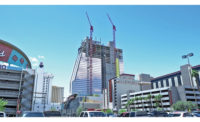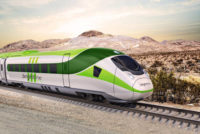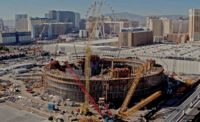A half-mile-long highway interchange bridge under construction in Las Vegas won’t be finished until the fall, but it already has carried a heavy load in terms of the complexity of its construction.
The Nevada Dept. of Transportation (NDOT) project is being built on a small construction footprint within a tight schedule—and in the middle of traffic from the two major highways it will connect. The 2,635-ft-long flyover will join northbound U.S. Highway 95 to the westbound 215 beltway in northwest Las Vegas, part of a metro area that adds about 1,500 residents a week.
U.S. 95 is a major thoroughfare that travels through downtown Las Vegas and then heads north to Reno. The beltway, which circles much of the valley, has been built in phases over the last 25 years. Currently, motorists going between the highways have to connect via surface streets, adding 15 minutes to rush-hour trips. About 55,000 vehicles use the area’s freeways daily. That number is expected to grow by 75% over the next two decades.
The new bridge, the second longest in the state, will become the centerpiece of the anticipated 21-month-long, $73-million Centennial Bowl Interchange project that broke ground in January 2019. The interchange, funded by a mix of state and federal dollars, is intended to ease travel in the immediate area and improve access to raw land in far northwest Las Vegas, an area supporting the city’s growth.
“This project helps create a reliable transportation network in the northwest valley,” says Clark County Commissioner Larry Brown, who represents the area. “It improves accessibility, mobility and safety for residents and businesses.”
Concurrent Construction
General contractor Las Vegas Paving Corp. is building the 75-ft-tall by 39-ft-wide box-girder bridge from cast-in-place, post-tensioned concrete. The bridge is expected to use 14,270 cu yd of concrete delivered by 1,500 truck trips. Another flyover is going up concurrently, crossing beneath the larger span and above the traffic on U.S. 95. Building both bridges at once allows NDOT to reduce the duration of lane restrictions on the highway below.
But as motorists who travel the area daily have learned, minimizing restrictions doesn’t mean escaping them. “We had to take four lanes down to two lanes for about a year,” says Brian Boedigheimer, supervisor and associate engineer for NDOT. “That causes major congestion northbound in the afternoon and some uncomfortable ramp access in the mornings southbound. Good people spent days and days and days trying to find a safer and more timely way to do it,” he says. “Now we are just opening these [lanes] back up as we can.”
Placing restrictions on some of the busiest roadways in the state requires constant outreach from NDOT to the public. For that, the department has relied on public relations skills honed during Project Neon, the recently concluded $1-billion rebuild of Interstate 15 through downtown Las Vegas. During the three-year project, the department made thousands of social media posts and provided press releases, website updates and YouTube videos, giving the agency a proven template for community outreach.
Design Complexities
Project Neon and a string of other major highway projects in the nation’s second-fastest-growing state have tested the skills of NDOT’s engineering and design team. “Challenges are daily because of the complexity of the design,” says resident engineer Abid Sulahria, who is in charge of the project. “But we learned from the earlier phase of this project, and we learn from everything we do.”
Boedigheimer says minimizing delays is the main goal, but “as you build the falsework for the bridges, you only get so much span for each I-beam.”
The flyovers are supported by 1,800 linear ft of falsework and 5.2 million lb of reinforcing steel. The dual bridges also sit atop a foundation of 60 piles, 10 ft in diameter and drilled up to 80 ft deep. The flyover structure consists of four frames. Two have been finished and the third awaits the girder walls and top deck, making the bridge about two-thirds complete, with an estimated completion date of late September. Crews are working six days a week, but that’s expected to go down to five as highway restrictions are reduced.
When work on the Centennial Bowl is completed, it will include three decks and 19 bridges. The under-construction flyover—which, unlike a cloverleaf, will allow freeway-to-freeway connections without slowing traffic down—is made up of four separate bridges that will be connected at the end of the project. The bridges also are not being constructed sequentially, with the portion over U.S. 95 being built before either of the adjoining spans.
From his onsite office, barely 20 ft from a busy freeway on ramp, Sulahria says the demands of the work—constrained by a tight staging area, tight deadlines and constant traffic—made developing clear lines of communication a key goal for the project team. “We take the personalities and personal issues out of it and deal with it as a project,” he says.
Dave Simmons, a superintendent for Las Vegas Paving Corp., agrees. “We can come in and talk, and if we have an issue, we can resolve it. You get that trust factor,” he says.
Construction crews are working around two active freeway systems as well as a network of busy surface streets, leaving only slivers of state right-of-way land for building materials and equipment storage. The contractor rented a $5,000-a-day crane to erect flyover bridge falsework, but moving the machine from one side of the freeway to the other meant detailed traffic planning, manpower coordination and stakeholder outreach to minimize costs.
“With four corners of the job on opposite sides of the freeway, it’s a scheduling nightmare just getting the equipment back and forth,” Simmons says.
The focus on planning has paid off in a project with no lost-time injuries so far. Nearly three dozen workers—from the carpenters, laborers, teamsters and operating engineers unions—are typically found on site, but the number goes up on days with big concrete placement. “On our busiest days we’ve had up to 200 people on site,” Boedigheimer says.
Simmons says hiring is tough in booming Las Vegas, where an NFL stadium, two resorts and a major expansion of the convention center also are under construction. “Good help is hard to find, but they’re out there,” he says.
NDOT’s Sulahria says the bridge project will be defined by its scale and a commitment to quality throughout the design process. “We haven’t done a change order because of a plan error,” he says.
Boedigheimer says he’d like to get feedback from motorists on the prompt removal of lane restrictions and improved traffic flow, but he’s not holding his breath.
“I’ve heard there’s excitement on getting a straight shot to Sam’s Club,” which a new access road will provide, he says.
Bridging History
The flyover under construction in northwest Las Vegas will be 2,635 ft long, making it the second longest in Nevada. The longest in the state is a 1.6-mile viaduct on I-515 between Eastern Avenue and I-15 in downtown Las Vegas. NDOT is in the early planning stage for an eventual rebuild of that stretch of highway, which dates to the 1960s. About 35 miles southeast of Las Vegas near Hoover Dam, the Mike O’Callaghan–Pat Tillman Memorial Bridge connects Arizona and Nevada more than 900 ft above the Colorado River. The 10-year-old, 1,900-ft-long bridge is the world’s highest concrete arch bridge.










Post a comment to this article
Report Abusive Comment